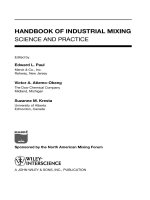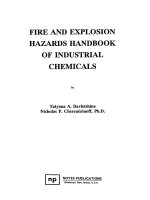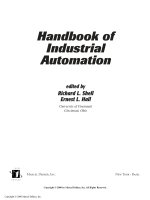Lawrie lloyd auth handbook of industrial catalysts
Bạn đang xem bản rút gọn của tài liệu. Xem và tải ngay bản đầy đủ của tài liệu tại đây (24.55 MB, 506 trang )
Handbook of Industrial Catalysts
FUNDAMENTAL AND APPLIED CATALYSIS
Series Editors: M. V. Twigg
Johnson Matthey
Catalytic Systems Division
Royston, Hertfordshire, United Kingdom
M. S. Spencer
Department of Chemistry
Cardiff University
Cardiff, United Kingdom
CATALYST CHARACTERIZATION: Physical Techniques for Solid Materials
Edited by Boris Imelik and Jacques C. Vedrine
CATALYTIC AMMONIA SYNTHESIS: Fundamentals and Practice
Edited by J. R. Jennings
CHEMICAL KINETICS AND CATALYSIS
R. A. van Santen and J. W. Niemantsverdriet
DYNAMIC PROCESSES ON SOLID SURFACES
Edited by Kenzi Tamaru
ELEMENTARY PHYSICOCHEMICAL PROCESSES ON SOLID
SURFACES
V. P. Zhdanov
HANDBOOK OF INDUSTRIAL CATALYSTS
Lawrie Lloyd
METAL-CATALYSED REACTIONS OF HYDROCARBONS
Geoffrey C. Bond
METAL–OXYGEN CLUSTERS: The Surface and Catalytic Properties of
Heteropoly Oxometalates
John B. Moffat
SELECTIVE OXIDATION BY HETEROGENEOUS CATALYSIS
Gabriele Centi, Fabrizio Cavani, and Ferrucio Trifir`o
SURFACE CHEMISTRY AND CATALYSIS
Edited by Albert F. Carley, Philip R. Davies, Graham J. Hutchings,
and Michael S. Spencer
A Continuation Order Plan is available for this series. A continuation order will bring delivery of each
new volume immediately upon publication. Volumes are billed only upon actual shipment. For further
information please contact the publisher.
PREFACE TO THE SERIES
Catalysis is important academically and industrially. It plays an essential role in
the manufacture of a wide range of products, from gasoline and plastics to
fertilizers and herbicides, which would otherwise be unobtainable or
prohibitively expensive. There are few chemical- or oil-based material items in
modern society that do not depend in some way on a catalytic stage in their
manufacture. Apart from manufacturing processes, catalysis is finding other
important and ever increasing uses; for example, successful applications of
catalysis in the control of pollution and its use in environmental control are
certain to increase in the future.
The commercial importance of catalysis and the diverse intellectual
challenges of catalytic phenomena have stimulated study by a broad spectrum of
scientists, including chemists, physicists, chemical engineers, and material
scientists. Increasing research activity over the years has brought deeper levels
of understanding, and these have been associated with a continually growing
amount of published material. As recently as sixty years ago, Rideal and Taylor
could still treat the subject comprehensively in a single volume, but by the
1950s. Emmett required six volumes, and no conventional multivolume text
could now cover the whole of catalysis in any depth. In view of this situation,
we felt there was a need for a collection of monographs, each one of which
would deal at an advanced level with a selected topic, so as to build a catalysis
reference library. This is the aim of the present series, Fundamental and Applied
Catalysis.
Some books in the series deal with particular techniques used in the study
of catalysts and catalysis: these cover the scientific basis of the technique, details
of its practical applications, and examples of its usefulness. An industrial
process or a class of catalysts forms the basis of other books, with information
on the fundamental science of the topic, the use of the process or catalysts, and
engineering aspects. Single topics in catalysis are also treated in the series, with
books giving the theory of the underlying science, and relating it to catalytic
practice. We believe that this approach provides a collection that is of value to
both academic and industrial workers. The series editors welcome comments on
the series and suggestions of topics for future volumes.
Martyn Twigg
Michael Spencer
Lawrie Lloyd
Handbook of Industrial
Catalysts
Lawrie Lloyd
Court Gardens 11
Bath
United Kingdom
ISSN 1574-0447
ISBN 978-0-387-24682-6
e-ISBN 978-0-387-49962-8
DOI 10.1007/978-0-387-49962-8
Springer New York Dordrecht Heidelberg London
Library of Congress Control Number: 2011931088
© Springer Science+Business Media, LLC 2011
All rights reserved. This work may not be translated or copied in whole or in part without the written
permission of the publisher (Springer Science+Business Media, LLC, 233 Spring Street, New York,
NY 10013, USA), except for brief excerpts in connection with reviews or scholarly analysis. Use in
connection with any form of information storage and retrieval, electronic adaptation, computer
software, or by similar or dissimilar methodology now known or hereafter developed is forbidden.
The use in this publication of trade names, trademarks, service marks, and similar terms, even if they
are not identified as such, is not to be taken as an expression of opinion as to whether or not they are
subject to proprietary rights.
Printed on acid-free paper
Springer is part of Springer Science+Business Media (www.springer.com)
PREFACE
The use of catalysts in chemical and refining processes has increased rapidly
since 1945, when oil began to replace coal as the most important industrial raw
material. Even after working for more than 35 years with catalysts, I am still
surprised to consider the present size of the catalyst business and to see how
many specialist companies supply different operators. Now that each segment of
the industry is so specialized no single organization is able to make all of the
catalyst types that are required. The wide range of catalysts being used also
means that it is difficult to keep pace with the details of every process involved.
Unfortunately, there are few readily available comprehensive descriptions of
individual industrial catalysts and how they are used. This is a pity, since
catalysts play such an important part in everyday life.
Modern catalyst use was unimaginable a hundred years ago because
catalysts were still chemical curiosities. The use of catalytic processes simply
increased with the demand for new products and gradual improvements in
engineering technology. Only now is it becoming true to say that catalyst design,
which originally relied on luck and the experience of individuals, is becoming a
more exact science. New construction materials have made plant operation more
efficient and led to the development of better processes and catalysts. It is no
coincidence that the two major wars of the twentieth century saw the rapid
expansion of a more sophisticated chemical industry. Currently, some new
catalysts are evolving from previous experience while others are being
specifically designed to satisfy new consumer demands. This is demonstrated by
the introduction of catalysts to reduce automobile exhaust emissions in response
to environmental regulations. This has been one of the major catalyst growth
areas of the past 20 years and the use of catalysts to control various industrial
emissions is similarly important.
The demand for catalysts is still increasing particularly in the Far East, as
expansion of the chemical and refining industries keeps pace with the increase in
world population. As a consequence, the number of catalyst suppliers is still
growing. All have the experience needed to produce large volumes of catalysts
successfully and can give good advice on process operation, but different
catalysts for the same applications are not always identical.
Ownership of key patents for catalysts and catalytic processes has led to
licenses being offered by chemical and engineering companies. For this reason
precise catalyst compositions are not often published, and while commercial
products may seem to differ only in minor details, in a particularly efficient
manufacturing process these can certainly improve performance. There are no
catalyst recipe books, and details regarded as company secrets are hidden in the
vague descriptions of a patent specification.
vii
viii
Preface
Competition among suppliers in a market where customers may only place
large orders every few years has encouraged overcapacity in order to meet
emergency requirements. At the same time, low selling prices and the high costs
of introducing new products have reduced profitability. The recent spate of
catalyst joint ventures reflects this.
Availability of reliable products must be guaranteed so that a customer’s
expensive plant will not have to close down or operate at a loss. Security of
supply is clearly a major factor in catalyst selection. Indeed, for many years it
was a strategic or political necessity as well as being of commercial importance.
For instance, during the ColdWar era, most of Eastern Europe and China had to
rely on their own domestic production capacity. At the same time, the big
chemical companies in the United States and Europe, which had traditionally
produced their own catalysts, began to buy the best available commercial
products.
Since Sabatier published Catalysis in Organic Chemistry in 1918 many
process reviews have been written on the industrial applications of catalysts and
they provide a good deal of historical background. Lack of detail has meant,
however, that catalyst compositions are not often included. In any case, earlier
reviews are usually out of print and can only be found with difficulty from old
library stock. Up-to-date information is badly needed.
Catalysts could, by definition, operate continuously, but those used
industrially may lose activity very quickly. Some catalysts can then be
regenerated at regular intervals by burning of carbon deposited during operation.
Others have to be replaced following permanent poisoning by impurities present
in the reacting gases. To avoid the necessity for parallel reactors or unscheduled
interruptions to replace spent catalyst, efficient operating procedures have had to
be devised for online regeneration or the removal of poisons from feedstock.
The use of additional catalysts or absorbents to protect the actual process
catalysts has become an important feature of operation. Catalysts are also
deactivated by overheating. This sinters either the active catalyst or the support
and occurs if the operating temperature is at the limit of catalyst stability,
particularly in the presence of trace impurities in feedstock. Other problems can
result from increasing pressure drop through the catalyst bed, if dust is entrained
with process gas or if the catalyst itself slowly disintegrates.
It may therefore be necessary to replace catalysts many times during the life
of plant equipment. Stability despite the presence of poisons becomes an
important feature of the selection procedure to avoid unscheduled plant closures.
Proper catalyst reduction may also be a critical step prior to operation to ensure
optimum performance in the shortest possible time. This is not always easy and
efforts have therefore been made to use prereduced catalysts and even to
regenerate spent catalysts externally to restore as much of the original activity as
possible. It should never be assumed that catalyst operation is straightforward. It
Preface
ix
is often a nightmare. And effort spent in solving problems or making
improvements is time consuming. The provision of an efficient technical service
has thus become an indispensable element of the catalyst business.
It is hoped that this extensive survey of industrial catalysis will stimulate a
wider general interest in the subject.
The author thanks J.R. Jennings, M. S. Spencer, and M.V. Twigg for much
help in bringing this book to publication.
Lawrence Lloyd
Bath, England
CONTENTS
Chapter 1
Industrial Catalysts
1.1 Introduction
1.2 What is a Catalyst?
1.2.1 Activity
1.2.2 Selectivity and Yield
1.2.3 Stability
1.2.4 Strength
1.3 Catalyst Production
1.3.1 Precipitation
1.3.2 Impregnation
1.3.3 Other Production Methods
1.4 Catalyst Testing
1.4.1 Physical Tests
1.4.2 Chemical Composition
1.4.3 Activity Testing
1.5 Catalyst Operation
1.5.1 Reactor Design
1.5.2 Catalytic Reactors
1.5.3 Catalyst Operating Conditions
1.6 Conclusion
References
1
5
6
7
7
8
8
12
13
13
14
14
14
15
18
18
18
20
21
22
Chapter 2
The First Catalysts
2.1 Sulfuric Acid
2.1.1 The Lead Chamber Process
2.1.1.1 Chemistry of the Lead Chamber Process
23
24
26
xi
xii
Contents
2.1.1.2 The Continuing Use of the Lead Chamber Process
2.1.1.3 Raw Material for Sulfuric Acid Production
2.1.2 Contact Process Development
2.1.3 Modern Sulfuric Acid Processes
2.1.3.1 Catalyst Preparation
2.1.3.2 Sulfuric Acid Plant Design
2.1.3.3 Cesium-Promoted Catalysts
2.1.3.4 Sulfuric Acid Plant Operation
2.1.3.5 Improved Catalyst Shapes
2.2 The Deacon Process
2.2.1 The Process
2.2.2 Operation
2.2.3 Catalyst Preparation
2.2.4 Development
2.3 Claus Sulfur Recovery Process
2.3.1 The Claus Process
2.3.2 Claus Plant Operation
2.3.3 Claus Process Catalysts
2.3.4 Catalyst Operation
2.4 Ammonia Synthesis
2.4.1 Sir William Crookes
2.4.2 Development of the Ammonia Synthesis Process
2.4.3 Commercial Application of Ammonia Synthesis Catalysts
2.4.4 The Haber–Bosch Synthesis Reactor
2.4.5 Conclusions
2.5 Coal Hydrogenation
2.5.1 The Bergius Process
2.5.2 Commercial Development by I. G. Farben
2.5.3 Cooperation between I. G. Farben and Standard Oil
2.5.4 Commercial Developments by ICI
2.5.5 International Cooperation
2.5.6 Coal Hydrogenation Processes
2.5.6.1 The I. G. Farben Process
2.5.6.2 The ICI Process
2.5.7 Catalysts for Coal Hydrogenation
2.5.8 Creosote and Other Feeds
2.6 The Fischer-Tropsch Process
2.6.1 Postwar Development of the Synthol Process by Sasol
2.6.2 The Importance of Gas-to-Liquids as Gasoline Prices Increase
References
27
28
29
35
36
37
38
39
39
39
40
40
41
41
41
42
42
45
46
48
49
51
52
53
54
55
55
56
56
56
57
57
58
59
60
61
63
65
68
69
Contents
xiii
Chapter 3
Hydrogenation Catalysts
3.1 The Development of Hydrogenation Catalysts
3.1.1 Sabatier and Senderens
3.1.2 The First Industrial Application of Nickel Catalysts
3.1.3 Ipatieff and High-Pressure Hydrogenation of Liquids
3.1.4 Colloidal Platinum and Palladium Catalysts by Paal
3.1.5 Platinum and Palladium Black Catalysts by Willstatter
3.1.6 Adams’ Platinum Oxide
3.1.7 Raney Nickel Catalysts
3.1.8 Nickel Oxide/Kieselguhr Catalysts
3.1.9 Nickel Oxide-Alumina Catalysts
3.1.10 Copper Chromite Catalysts
3.1.11 Copper Oxide/Zinc Oxide Catalysts
3.2. Hydrogenation of Fats and Oils
3.2.1 Process Development
3.2.2 Oil Hydrogenation
3.2.3 Fat Hardening Catalysts
3.2.4 Catalyst Selectivity
3.2.5 Feed Pretreatment
3.2.6 Catalyst Operation
3.2.7 Catalyst Poisons
3.3 Fatty Acid Hydrogenation
3.4 The Production of Fatty Alcohols
3.4.1 Natural Fatty Alcohols
3.4.2 Catalyst Operation
3.4.3 Reaction of Fatty Alcohols
3.5 Some Industrial Hydrogenation Processes
3.5.1 Nitrobenzene Reduction
3.5.2 Benzene Hydrogenation
3.5.2.1 Removal of Aromatics
3.5.3 Hydrogenation of Phenol
3.6 Selective Hydrogenation of Acetylenes and Dienes
3.6.1 Acetylene Hydrogenation Process Design
3.6.2 Early Acetylene Hydrogenation Catalysts
3.6.2.1 Sulfided Cobalt Molybdate
3.6.2.2 Sulfided Nickel Oxide
3.6.2.3 Fused Iron Oxide
3.6.2.4 Palladium Catalyst Guard Beds
73
73
75
75
76
76
78
78
80
83
85
86
89
89
90
91
93
94
94
96
96
97
97
98
98
99
99
100
101
101
102
104
105
105
105
106
106
xiv
Contents
3.6.3
3.6.4
3.6.5
3.6.6
Modern Acetylene Hydrogenation Catalysts
Acetylene Hydrogenation Catalyst Preparation
Acetylene Hydrogenation Catalyst Operation
3.6.5.1 Tail-End Acetylene Hydrogenation
3.6.5.2 Tail-End Methyl Acetylene/Propadiene
Hydrogenation
3.6.5.3 Front-End Acetylene Hydrogenation
Selective Hydrogenation of Pyrolysis Gasoline
3.6.6.1 Catalyst Types
3.6.6.2 Catalyst Operation
References
106
107
107
107
109
110
112
113
114
115
Chapter 4
Oxidation Catalysts
4.1 Nitric Acid
4.1.1 The Ammonia Oxidation Process
4.1.2 Catalyst Operation
4.1.3 Platinum Recovery
4.2 Formaldehyde
4.2.1 Silver Catalyst Operation
4.2.2 Mixed Oxide Catalyst Operation
4.3 Andrussov Synthesis of Hydrogen Cyanide
4.4 Hopcalite Catalysts For Carbon Monoxide Oxidation
4.5 Phthalic Anhydride
4.5.1 Naphthalene Oxidation
4.5.2 Orthoxylene Oxidation
4.6 Maleic Anhydride
4.6.1 Benzene Feedstock
4.6.2 n-Butene Feedstock
4.6.3 n-Butane Feedstock
4.6.4 n-Butane Oxidation in a Circulating Fluidized Bed
4.7 Ethylene Oxide
4.7.1 Catalyst
4.7.2 Operation and Reaction Mechanism
4.7.3 Applications of Ethylene Oxide
4.8 A Redox Oxidation Mechanism: Mars and Van Krevelen
4.9 Acrolein and Acrylonitrile
120
124
128
130
131
136
136
137
139
140
141
142
144
144
144
148
149
150
152
153
154
155
156
Contents
Manufacture of Mixed Oxide Catalysts for Acrolein
and Acrylonitrile
4.9.2 The Acrylonitrile Process
4.9.3 Reaction Mechanism
4.9.4 Partial Oxidation of Propane
4.9.5 Acrylic Acid
4.9.6 Oxidation of Isobutene
4.10 Oxidative Dehydrogenation of n-Butenes to Butadiene
References
xv
4.9.1
157
158
159
161
161
162
162
163
Chapter 5
Catalytic Cracking Catalysts
5.1 Introduction
5.2 Process Development
5.2.1 Fixed Beds
5.2.2 Moving and Fluidized Beds
5.2.3 Catalyst Regeneration and Carbon Monoxide Combustion
5.2.3.1 Catalyst Regeneration
5.2.3.2 Carbon Monoxide Combustion Promoter
5.2.4 Equilibrium Catalyst
5.2.5 Reaction Mechanism of Catalytic Cracking Reactions
5.3 Catalyst Development
5.3.1 Natural Clay Catalysts
5.3.2 Synthetic Silica Alumina Catalysts
5.3.3 Preparation of Synthetic Catalysts
5.4 Zeolite Catalysts
5.4.1 Commercial Zeolites
5.4.2 Production of Zeolites
5.4.3 Formation of Active Sites by Ion Exchange
5.4.4 Use of Zeolites in Catalytic Cracking
5.4.5 The Catalyst Matrix
5.5 Octane Catalysts (Catalysts to Increase Octane Rating)
5.5.1 Hydrothermal Dealumination of Y-Zeolites
5.5.2 Chemical Dealumination of Y-Zeolites
5.5.3 Increasing Octane Number
5.5.4 Shape Selective Cracking
5.6 Residue Cracking Catalysts
5.6.1 Residual Feeds
169
170
170
171
175
175
176
177
178
180
181
182
182
184
185
188
189
190
191
192
193
195
196
197
198
198
xvi
Contents
5.6.2 Residue Catalyst Formulation
5.6.3 Coke Formation
5.7 Residue Catalyst Additives
5.7.1 Nickel Additives
5.7.2 Vanadium Additives
5.7.3 Sulfur Oxides Transfer Additives
5.7.4 Bottoms Cracking Additive
5.8 Reformulated Gasoline
References
199
199
201
201
202
203
206
206
209
Chapter 6
Refinery Catalysts
6.1 The Development of Catalytic Refinery Processes
6.2 Polymer Gasoline
6.3 Alkylation
6.3.1 Liquid Acid Processes
6.3.2 The Mechanism of Alkylation with an Acid Catalyst
6.3.3 Liquid Acid Operating Conditions
6.3.4 Processes Using Solid-State Acid Catalysts
6.4 Hydrotreating
6.4.1 What Is Hydrotreating?
6.4.2 Hydrotreating Processes
6.4.2.1 Catalyst Production and Operation
6.4.2.2 Catalyst Handling
6.4.2.3 Activating the Catalyst
6.4.2.4 Catalyst Operation
6.4.2.5 Catalyst Regeneration
6.5 Hydrocracking
6.5.1 Hydrocracking Processes
6.5.1.1 Single-Stage Processes
6.5.1.2 Two-Stage Processes
6.5.1.3 Once-Through Process
6.5.2 Hydrocracking Catalysts
6.5.2.1 Acid Supports
6.5.2.2 Hydrogenation Catalysts
6.5.2.3 Catalyst Preparation
6.5.2.4 Catalyst Activity
6.5.2.5 Catalyst Reactivation
211
213
217
219
219
220
221
221
223
223
224
225
227
229
229
231
232
233
234
234
235
235
236
236
237
237
Contents
6.6 Catalytic Reforming
6.6.1 Naphtha Reforming Reactions
6.6.1.1 Reformer Operation
6.6.1.2 Coke Formation
6.6.2 Reforming Catalysts
6.6.2.1 Bimetallic Catalysts
6.6.2.2 Catalyst Preparation
6.6.3 Catalyst Regeneration
6.6.3.1 Carbon Burn
6.6.3.2 Oxychlorination
6.6.3.3 Platinum Re-Dispersal
6.6.3.4 Catalyst Reduction
6.6.4 Catalyst Life
6.7 Octane Boosting
6.7.1 Selectoforming
6.7.2 M-Forming
6.8 Aromatics Production
6.8.1 Aromatics Process
6.8.2 Cyclar Process
6.8.3 M2-Forming Process
6.9 Catalytic Dewaxing
6.10 Isomerization
6.10.1 Isomerization Catalysts
6.10.2 Reaction Mechanism
References
xvii
238
240
240
246
247
248
250
251
252
252
252
253
253
253
253
254
254
254
255
255
255
256
256
257
258
Chapter 7
Petrochemical Catalysts
7.1 The Development of Petrochemicals
7.1.1 Isopropyl Alcohol
7.1.1.1 Acetone
7.1.1.2 Bisphenol-A
7.1.1.3 Cumene
7.1.2 Vinyl Chloride
7.1.2.1 The Oxychlorination Reaction
7.1.2.2 Oxychlorination Catalyst
7.1.2.3 Catalyst Operation
7.2 Synthetic Rubber From Butadiene and Styrene
261
265
265
266
266
267
270
270
271
273
xviii
Contents
7.2.1
7.2.2
Butadiene from Butane
Butadiene from Butenes
7.2.2.1 Oxidative Dehydrogenation
7.2.3 Propylene from Propane
7.2.4 Styrene
7.2.4.1 Ethylbenzene Production
7.2.4.2 Styrene Production after 1950
7.2.4.3 Styrene Plant Operation
7.2.4.4 Ethylbenzene Dehydrogenation (Styrene) Catalysts
7.3 Synthetic Fibers
7.3.1 Nylon 66
7.3.1.1 Production of Nylon Intermediates
7.3.1.2 Adipic Acid
7.3.1.3 Hexamethylenediamine
7.3.1.4 Nylon Polymer
7.3.2 Nylon 6
7.3.2.1 Caprolactam
7.3.2.2 Cyclohexanone
7.3.2.3 Cyclohexanone Oxime
7.3.2.4 Snia-Viscosa Process
7.3.2.5 Conversion of Cyclohexanone Oxime to Caprolactam
7.3.2.6 Caprolactam from Butadiene
7.3.3 Polyesters
7.3.3.1 Paraxylene
7.3.3.2 Terephthalic Acid
7.3.3.3 Alternative Routes for Terephthalic Acid Production
7.3.3.4 Use of Polyesters
7.4 Hydroformylation and Carbonylation
7.4.1 Cobalt Carbonyl Catalysts
7.4.2 Phosphine Modified Catalysts
7.4.3 Low-Pressure Hydroformylation
7.4.4 Commercial Operation
7.4.5 Acetic Acid
7.4.6 Acetaldehyde
7.5 Metathesis of Olefins
7.5.1 Process Development
7.5.2 The Shell Higher-Olefins Process
References
275
275
277
277
278
279
281
282
283
283
284
285
285
286
288
289
289
290
290
291
291
292
292
293
294
296
296
297
297
298
300
301
301
303
304
304
305
306
Contents
xix
Chapter 8
Olefin Polymerization Catalysts
8.1 Low-Pressure Polyethylene
8.1.1 Polyethylene Process Development
8.1.2 The Development of Polypropylene Catalysts
8.2 Ziegler–Natta Catalysts
8.2.1 Early Polyolefin Catalysts
8.2.2 Ziegler’s Brown Titanium Trichloride
8.2.3 Natta’s Violet Titanium Trichloride
8.2.4 Second-Generation Propylene Polymerization Catalysts
8.2.5 Supported Polyethylene Catalysts
8.2.6 Supported Polypropylene Catalysts
8.2.6.1 Third-Generation Catalysts
8.2.6.2 Fourth-Generation Catalysts
8.3 Phillips Polyethylene Catalysts
8.3.1 Catalyst Production
8.3.2 Catalyst Reduction
8.3.4 Catalyst Operation
8.3.5 Catalyst Modifiers
8.3.5.1 Titanium
8.3.5.2 Alumina and Zirconia
8.3.5.3 Fluorides
8.3.6 Use of Co-catalysts
8.3.7 Organo-chromium Catalysts
8.4 Other Catalysts
8.5 Polymerization Processes
8.5.1 Slurry Processes
8.5.2 Solution Processes
8.5.3 Gas Phase Process
8.6 Metallocene/Single-Site Catalysts
8.6.1 Early Development
8.6.2 Early Development
8.6.3 Industrial Operation
8.6.4 Catalyst Activators
8.6.5 Molecular Weight Control
8.6.7 New Catalyst Developments
8.7 The Molecular Structure of Polyolefins
8.7.1 Formation of Polymer Chains
312
313
314
314
314
315
316
317
319
320
320
321
322
323
324
324
325
326
327
327
327
328
329
329
332
332
333
334
335
336
338
338
339
340
341
341
xx
Contents
8.7.2 Polymer Chain Termination
8.7.3 Molecular Weight
References
342
344
345
Chapter 9
Synthesis Gas
9.1 Ammonia Synthesis Gas
9.1.1 Process Developments
9.1.2 Increased Ammonia Production by Steam Reforming
9.2 Modern Ammonia Plants
9.3 Feedstock Purification
9.3.1 Activated Carbon
9.3.2 Hydrodesulfurization
9.3.3 Chlorine Removal
9.3.4 Sulfur Absorption
9.3.4.1 Operation with Zinc Oxide
9.3.4.2 Preparation of Zinc Oxide
9.3.4.3 Desulfurization of Other Gases
9.4 Steam Reforming
9.4.1 Reformer Design
9.4.2 Reforming Catalysts
9.4.3 Reformer Operation
9.4.4 Secondary Reforming
9.5 Carbon Monoxide Removal
9.5.1 High Temperature Carbon Monoxide Conversion
9.5.2 High Temperature Conversion Catalysts
9.5.2.1 Operating Conditions
9.5.3 Low Temperature Carbon Monoxide Conversion
9.5.3.1 Operation
9.5.3.2 Catalyst
9.6 Methanation
9.6.1 Operation
9.6.2 Catalyst
9.6.3 Other Methanation Processes
9.7 Other Applications of Steam Reforming
9.7.1 Methanol Synthesis Gas
9.7.2 OXO Synthesis Gas
9.7.3 Hydrogen Production
9.7.4 Reducing Gas
352
353
354
355
357
358
358
360
360
361
363
363
363
365
369
371
374
375
376
377
378
379
381
384
385
386
387
388
389
389
390
390
391
Contents
9.7.5 Town Gas Production
9.7.6 Substitute Natural Gas
9.7.7 Autothermal Reforming
References
xxi
391
392
393
395
Chapter 10
Ammonia and Methanol Synthesis
10.1 Ammonia Synthesis
10.1.1
Process Development from 1920
10.1.1.1 Haber-Bosch Process
10.1.1.2 Claude Process
10.1.1.3 Casale Process
10.1.1.4 United States of America
10.1.1.5 Mont Cenis/Uhde Process
10.1.1.6 United Kingdom
10.1.2
Ammonia Synthesis Catalysts
10.1.2.1 Catalyst Production
10.1.2.2 Pre-reduced Catalysts
10.1.2.3 Loading Catalyst to Converter
10.1.2.4 Catalyst Discharge from the Converter
10.1.3
Catalyst Reduction
10.1.3.1 Reduction of Oxidized Catalyst
10.1.3.2 Reduction of Pre-reduced Catalyst
10.1.3.3 Mechanism of Catalyst Reduction
10.1.4
The Ammonia Synthesis Process
10.1.4.1 The Ammonia Synthesis Loop
10.1.4.2 Converter Design
10.1.5
New Catalyst Developments
10.1.5.1 Magnetite Catalyst Containing Cobalt
10.1.5.2 Ruthenium Catalyst
10.1.5.3 Catalyst Preparation
10.1.5.4 Full-scale Operation with Ruthenium Catalyst
10.2 Methanol Synthesis
10.2.1
High-pressure Synthesis
10.2.1.1 Zinc Oxide-Chromium Oxide Catalysts
10.2.1.2 High-Pressure Operation
10.2.2
Low-pressure Synthesis
10.2.2.1 Copper Oxide Catalysts
10.2.2.2 Copper Catalyst Production
397
399
399
400
401
402
403
403
405
405
407
408
409
409
409
410
410
412
412
414
417
418
419
419
420
421
421
421
423
425
426
426
xxii
Contents
10.2.2.3 Precipitates Forming During Production
10.2.2.4 Operation with Copper Catalysts
10.2.2.5 Reaction Mechanism with Copper Catalysts
10.2.2.6 Selectivity
10.2.2.7 Low-pressure Methanol Reactor Types
10.2.2.8 Catalyst Reduction
10.3 Novel Catalysts
References
430
431
432
432
433
433
434
435
Chapter 11
Environmental Catalysts
11.1 Stationary Sources
11.1.1 Selective Catalytic Reduction
11.1.2 Selective Catalytic Reduction Catalysts
11.1.2.1
Catalyst Composition
11.1.2.2
Catalyst Operation
11.1.2.3
Reaction Mechanism
11.1.2.4
Removal of Sulfur Dioxide as Sulfuric Acid
11.1.3 Gas Turbine Exhausts
11.1.3.1
Low Temperature Vanadium Pentoxide Catalysts
11.1.3.2
Catalytic Combustion Processes
11.1.4 Nitric Acid Plant Exhaust Gas
11.1.5 Ion-exchanged ZSM-5 Zeolites
11.2 Mobile Sources
11.2.1 Automobile Emission Control
11.2.2 Automobile Emission Control Catalysts
11.2.2.1
Bead Catalysts
11.2.2.2
Monolith Catalysts
11.2.2.3
Washcoat Composition
11.2.2.4
Platinum Group Metal Catalysts
11.2.2.5
Catalyst Poisons
11.2.3 Platinum Metal Group Availability
11.2.4 Catalyst Operation
11.2.5 Nitrogen Oxide Removal in Lean-Burn Engines
11.2.6 Diesel Engines
11.3 Volatile Organic Compounds
11.3.1 VOC Removal Processes
11.3.2 VOC Oxidation Catalysts
Reference
Index
441
443
445
446
447
447
448
449
449
449
450
451
452
452
455
456
456
457
458
459
460
460
463
464
465
466
468
469
471
1
INDUSTRIAL CATALYSTS
1.1. INTRODUCTION
The first industrial catalyst was probably the niter pot, which was used in the
early sulfuric acid lead chamber process when it became known that oxides of
nitrogen catalyzed the oxidation of sulfur dioxide. How was this important process—on which chemical development soon depended—discovered? Was it
from the observation that cannons corroded or that condensation was acidic following the explosion of gunpowder? All the ingredients for chamber acid were
there—sulfur, saltpeter, atmospheric air, and heat. Ostwald noted that “copious
brown fumes” were evolved as gunpowder exploded, but did not make any
comment on sulfur oxides.1 Empirical observations, or inspired deductions, during the 1800s led to the introduction of several more important catalytic
processes. The inevitable development of a chemical industry based on the use
of catalysts followed from a mass of experimental observations, such as those
shown in Table 1.1, accumulated after Berzelius2 defined catalysts in 1835 (Figure 1.1).
Although the first catalyst was a gas, there are only a few homogeneous
catalysts in use today. Most industrial catalysts are solids and operate heterogeneously in gas or liquid phase reactions.
Most of the basic ideas of industrial catalysis gradually evolved during the
early period of development. The use of particular groups of metals for hydrogenation and oxidation reactions was investigated first in the laboratory and then
industrially. Simple reactors with better control of operating conditions were
L. Lloyd, Handbook of Industrial Catalysts, Fundamental and Applied Catalysis,
DOI 10.1007/978-0-387-49962-8_1, © Springer Science+Business Media, LLC 2011
1
2
Chapter 1
Figure 1.1. Portrait of Baronn Berzelius.
uced. The new
w processes acccelerated the use of better steels and higghintrodu
pressurre technology, which, in turn
n, led to the deevelopment off further catalyytic
processses.
It was
w soon realizzed that in man
ny reactions a ssupport for thee active metal nnot
only made
m
the cataly
yst more activee and stable buut also reducedd the cost of tthe
final prroduct. Early supports
s
for meetal catalysts w
were natural orr refractory maaterials su
uch as asbesttos, pumice, quartz,
q
corunddum, activatedd carbon, clayys,
firebricck, and kieselg
guhr. Even during
d
the peeriod from 19950 through tthe
1970s, graded river pebbles
p
were often used ass catalyst bed ssupports, and tthe
originaal catalytic craacking catalystss from the 19300s were based on natural clayys.
Ammonia synthesis, one of the earlliest large-scalee industrial proocesses, still usses
ular catalyst maade by the fusion of a pure naatural magnetitte.
a granu
Th
he gradual evo
olution of moree reliable suppported metal ccatalysts requirred
reprodu
ucible supports. Industrial prrocesses for thhe production of pure alumiina
and silica were soon developed. Th
his led naturallly to the contrrol and measurreo chemical and
d physical properties at all sstages of catalyyst production to
ment of
ensure optimum surfaace area and po
ore structure. C
Controls were aat first empiriccal,
d on consistentt production coonditions. It waas not until 19938
and quality depended
m
surfacce area and porre volume werre introduced aand
that tecchniques for measuring
modern
n methods off catalyst quality control aand characterizzation began to
evolve..21
Industrial Catalysts
TABLE 1.1. Some Examples of Catalysis before 1925.
Date
Process
Reference
1740
Sulfur dioxide oxidation in glass bell jars.
Ward3
1746
1788
Sulfur dioxide oxidation in lead chamber.
Oxidation of ammonia to nitrogen oxides over
manganese dioxide.
Hydrolysis of starch to glucose in acid solution.
Ignition of combustible gases, such as coal gas, in air
over hot platinum wire.
Absorption and combustion of ethanol to give acetic
acid over spongy platinum—also combustion of
hydrogen over spongy platinum (Dobereiner’s Tinder
Box).
Reaction of hydrogen and chlorine over platinum.
Oxidation of sulfur dioxide with air over platinum.
Platinum poisoned by hydrogen sulfide and carbon
monoxide.
First definition of a catalyst.
Oxidation of ammonia to nitrogen oxides over platinum
0
sponge at 300 C.
Oxidation of hydrochloric acid to chlorine over copper
chloride.
First sulfuric acid contact process plant making oleum
from lead chamber acid.
Removal of sulfur and arsenic poisons from feed to
Deacon process.
Steam reforming of hydrocarbons over nickel oxide
/pumice.
BASF operated first pyrites contact process plant using
platinum catalyst.
First plant for partial oxidation of methanol to produce
formaldehyde used platinized asbestos but changed to
copper oxide.
Sulfur recovery from reaction of hydrogen sulfide and
sulfur dioxide over alumina catalyst.
BASF developed two bed contact process (first bed iron
oxide/second bed platinum catalysts).
Hydrogenation of vegetable oils.
Development of ammonia oxidation with platinum
catalysts.
Haber starts work on ammonia synthesis osmium
catalyst.
−
First nitric acid plant at Bochum (300 kg day 1).
Polyvinyl chloride.
Patent for iron oxide/chromium oxide carbon monoxide
conversion catalyst.
First patent of methanol synthesis process.
First synthetic ammonia plant at Oppau.
Fischer–Tropsch process.
First synthetic methanol plant at Merseberg.
Roebuck4
Milner5
1812
1817
1823
1826
1831
1831
1836
1839
1860–1870
1875
1876
1888
1888
1889
1894
1898
1899
1901–1904
1904
1905
1912
1912
1913
1914
1922
1923
Kirchoff 6
Davy7
Dobereiner8
Turner9
Phillips10
Henry11
Berzelius2
Kuhlmann12
Deacon13
Squire and Messel14
Hasenclever15
Mond and Langer16
Trillat17
Chance and Claus18
Oswald and Brauer19
Wild
Mittasch and Schneider
Bosch and Mittasch20
Fischer and Tropsch20
Pier and Winkler20
3
4
Chapter 1
When using catalysts industrially it is important that the shape and size of
the particles selected provide a proper balance between activity in the process
and pressure drop through the reaction vessel. Thus, process design plays an
important role in catalyst development. As catalysts are used and handled in
increasingly large quantities, physical strength is one of the common factors in
selecting any of the available shapes shown in Table 1.2.
Some catalysts can now be regarded as mini-reactors and are designed that
way. For example, the auto exhaust catalyst is supported on a monolith small
enough to fit underneath an automobile. On a molecular scale, metallocene
compounds are single-site catalysts that are now being used to make polyolefins more selectively. It is probably not necessary to emphasize that the
industrial catalysts used in chemical and refining processes are not the same as
the catalysts of theory. They all have well-defined features related to the basic
demands of the process in order to achieve predictable and economic operation.
These are shown in Table 1.3.
Catalyst manufacture is a specialized operation with producers working
continuously to improve performance and quality. More than 90% of today’s
chemical and refining processes use catalysts. The world is dependent on catalysts for food, fuel, plastics, synthetic fibers, and many other everyday
commodities, and there is no way that modern life would be the same if they
were not available. Even so, operators have often ignored new refinements in
various catalytic processes and have continued with a relatively inactive catalyst
TABLE 1.2. Common Catalyst Shapes and Sizes.
Shape
Powder
Process
Fluid catalytic cracking.
Acrylonitrile production.
Granules
Ammonia syntheses.
Balls/spheres
Desulfurization.
Hydrogenation.
Catalytic reforming.
Pellets
Reactions in adiabatic beds.
Extrusions
Hydrodesulfurization.
Sulfuric acid.
Rings
Hydrocarbon steam reforming.
Butane oxidation.
Flakes
Vegetable oil hydrogenation.
Gauze
Nitric acid.
Hydrogen cyanide.
Monoliths
Automobile exhaust purification.
Alloys
Hydrogenation.









